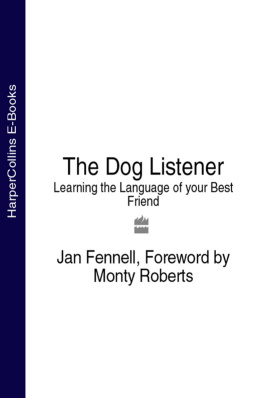CONTENTS
Guide
This ebook contains the following accessibility features which, if supported by your device, can be accessed via your ereader/accessibility settings:
- Change of font size and line height
- Change of background and font colours
- Change of font
- Change justification
- Text to speech
- Page numbers taken from the following print edition: ISBN 9780007153725
Harper
An Imprint of HarperCollinsPublishers Ltd
1 London Bridge Street
London SE1 9GF
www.harpercollins.co.uk
First published in Great Britain by HarperCollinsEntertainment 2004
Copyright Jan Fennell and Fantasma Partnership 2004
The Author asserts the moral right to be identified as the author of this work
All rights reserved under International and Pan-American Copyright Conventions. By payment of the required fees, you have been granted the nonexclusive, non-transferable right to access and read the text of this e-book on screen. No part of this text may be reproduced, transmitted, downloaded, decompiled, reverse engineered, or stored in or introduced into any information storage retrieval system, in any form or by any means, whether electronic or mechanical, now known or hereinafter invented, without the express written permission of HarperCollins e-books.
HarperCollinsPublishers has made every reasonable effort to ensure that any picture content and written content in this ebook has been included or removed in accordance with the contractual and technological constraints in operation at the time of publication
Source ISBN 9780007153725
Ebook Edition APRIL 2019 ISBN: 9780008363437
Version: 2019-05-13
Formulating the ideas that make up my method of communicating with dogs was a slow, almost imperceptible, invisible process. There was no real eureka moment, no apples fell from the trees. For years, usually without my realising it, people or events provided me with pieces in a giant jigsaw puzzle. Then one day I looked down to see that jigsaw complete.
The short version of the story is this. As my involvement in the dog world grew through the 1970s and 1980s, I had begun to harbour a deep distrust of traditional training methods. I attended and even ran my fair share of classes promoting these views, but I felt more and more that they were too aggressive, too reliant on the domination of the owner and the subjugation of the dog to his or her will. I felt there had to be another way.
The turning point came early in the 1990s, when fate conspired to take me by the hand. It was then that I saw a demonstration by the American horse whisperer Monty Roberts. It was an inspiration to see the way he invited the horses to follow him of their own free will, using signals that the animals understood instinctively, rather than resorting to violence or aggressive behaviour of any sort. Monty and his join up method set me thinking about whether it was possible to replicate this in dogs, to connect once more with the lost language that man and his best friend shared thousands of years ago.
While I had always been interested in dogs, by now I had begun to see them and their behaviour in a broader historical context, specifically in terms of their relationship with their ancient ancestor, the wolf.
I had discovered that wolf packs operate according to a strict hierarchy, with the Alpha pair as leaders and sole decision makers and the remainder of the pack ranked below according to a strict pecking order. Studying films and documentaries about wolves, I saw that the Alpha pair used four key moments in the day-to-day life of the pack to assert and sometimes reassert their authority. At mealtimes, for instance, they would always eat first. When it was time to go on the hunt, the Alpha pair would lead. At times of perceived danger, the Alphas would either withdraw the pack to safety or confront the threat on their behalf. And, finally, when the pack were reunited after a separation of some kind, the subordinates would pay the Alpha pair some kind of homage, licking frantically at their faces and carrying their bodies and tails lower than their leaders.
At the time, I had a pack of highly intelligent and responsive dogs sharing my life. As I studied the way they interacted more closely, I was surprised to see my own pack indulged in its share of ritualistic behaviour too. Like all dogs, they misbehaved here and there, but they also seemed to do so in a repetitive way, as if there was a pattern to it. As I watched them more closely, I saw striking similarities to the behaviour within the wolf packs. I realised my dogs became most agitated at mealtimes, as we prepared for our walks, when visitors arrived at the house and on my return from work in the evenings. What was more, they interacted with each other in a way that suggested there was a pecking order between them. For instance, my German shepherd, Sasha, seemed to carry herself in a more erect way, as if to keep a distance from the rest of the pack. At other times, she would interact with the rest of the pack, often licking them in a ritualised way. Clearly, the dog had been taken out of the wolf pack, but the wolf pack hadnt been taken out of the dog. I began to see that my dogs were operating according to the same, hard-wired instincts as their ancestors. There was some kind of hierarchy within the pack and their behaviour was being coloured by it.
The real breakthrough came when I realised they were treating me as part of the pack. At the time, my dogs jumped up at me when I came home, pulled at the lead whenever we went out on a walk, and barked and became agitated when people appeared unexpectedly at the door. I began to wonder whether my dogs believed I too was part of their hierarchy and whether they saw me as a subordinate member within our pack. Just because I saw myself as being the person responsible for looking after our domestic pack, it didnt mean that they shared that view. Suddenly, all sorts of behaviour were explained. If my dogs believed they were responsible for me, for instance, the causes of separation anxiety became clear. It was no longer a case of a dog pining for its owner when they were not at home, but one of a frantic parent desperate because it had lost its child and had no idea whether it was safe or not. If there was a eureka moment, then that was the closest Ive come to it.
From there I began to see that the key to changing my relationship with my dogs lay in removing the mantle of leadership from them and taking it on myself. What was particularly appealing about this was that if I could do this naturally, by using signals that they instinctively understood, they would relinquish this responsibility automatically, they would elect me leader of their own free will. There would be no need for violence, coercion or subjugation. The dogs would simply be listening to their instincts. Whats more, as long as I remained a convincing Alpha, they would follow my lead again as their instincts told them to.
Slowly, falteringly at first, I began to put together a system of signals, to be used at the four key times so that I could establish myself as leader of my own domestic pack. When we reunited after a separation I made sure we did so on my terms and at a time of my choosing, as a leader would do. I did this by ignoring any attention-seeking, waiting until the dogs calmed down, then calling them to me. In a similar vein I made sure the dogs were calm before leading them out on our walks. At the same time, I began to take charge of situations when there was a perceived danger to the pack. Here, if the dogs barked or got excited at the sign of a visitor at the door, I simply thanked them for alerting me to the danger, thereby relieving them of the responsibility of worrying. Finally, I took charge of mealtimes, taking a mouthful of a snack before laying down the food for my dogs to eat. Again, the idea was that if I was in control of the food then I must be the leader of the domestic pack. Throughout the process, I underscored everything with positive reinforcement, using food rewards to help speed the message that if they did the right thing, good things happened.
Next page













